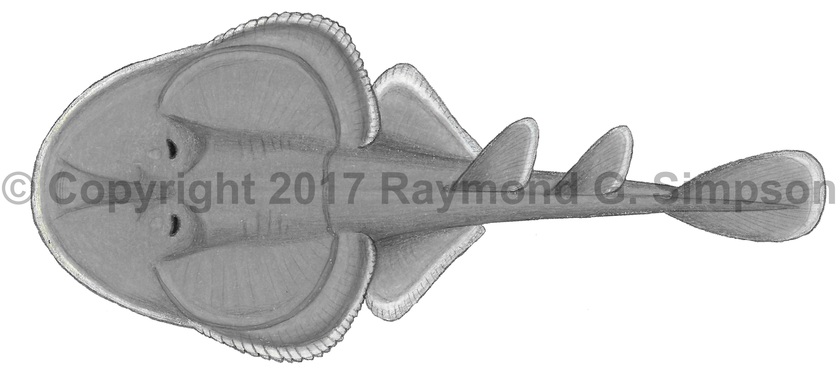
Common Name
Caribbean Blindray
Year Described
Bean & Weed, 1909
Identification
Disk moderate, thickened, and spade-shaped with kidney-shaped electric organs under each pectoral fin base. Body quite flat along entire width. Mouth relatively small with well developed labial cartilage. Teeth small (>20 rows) and visible when mouth is closed. Eyes buried in skin and visible only as faint spots anterior to spiracle. Spiracles large and round without papillae. Nostrils with broad nasal curtain. Pectoral fins very short and stumpy. Tail a little longer than disk and lacks spines or ridges. Dorsal fins about equal in size. Inter-dorsal space shorter than length of dorsal base. Pelvic fins conspicuous as single large single lobes off the base of the tail. Pelvic fins not joined. Caudal fin rounded with an obvious dorsal lobe. Skin entirely smooth.
Color
Disk uniformly pale brown, purplish-brown, or dark brown. Usually plain or with diffuse pale blotching. Ventrum whitish with yellowish blotching.
Size
Maximum size to 50cm TL.
Habitat
A deepwater species found on continental slopes and around islands from 200-1000m. Adults found in deeper water.
Range
Known from off the Carolinas to northern Cuba.
References
Last, P.R., White, W.T., Carvalho, M.R. de, Séret, B., Stehmann, M.F.W & Naylor, G.J.P (Eds.). 2016. Rays of the World. CSIRO Publishing, Melbourne.
Rincon, G., M.F.W. Stehmann, & C.M. Vooren. 2001. Results of the research cruises of FRV ‘Walther Herwig’ to South America. LXXIV. Benthobatis kreffti n. sp. (Chondrichthyes, Torpediniformes, Narcinidae), a new deep-water electric ray from off South Brazil and the third species of the genus. Archive of Fishery and Marine Research, 45-60.
Other Notes
A much larger species than Benthobatis kreffti with much larger upper caudal lobes and broader disk. Also widely allopatric.